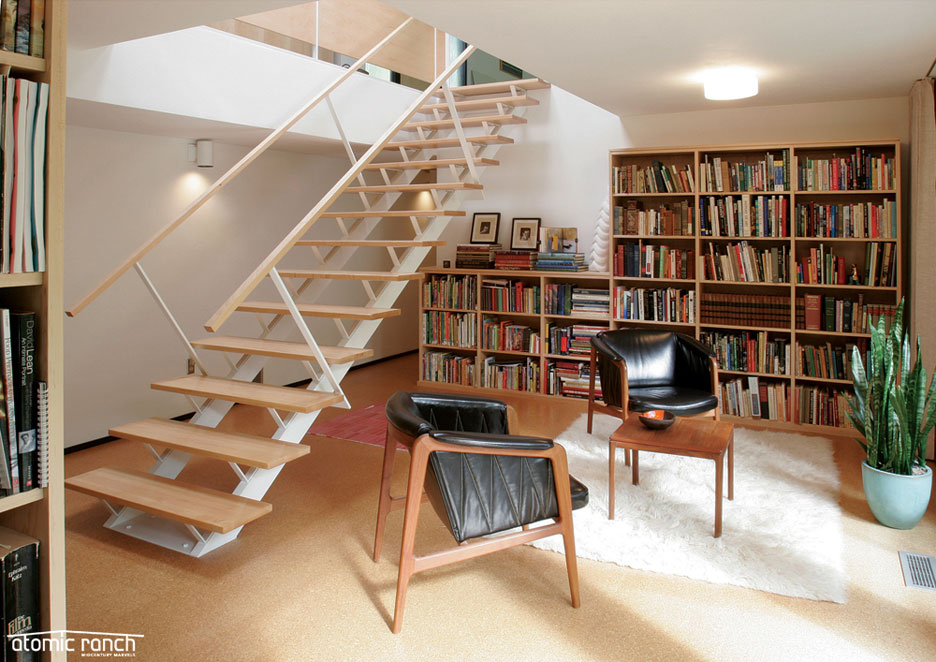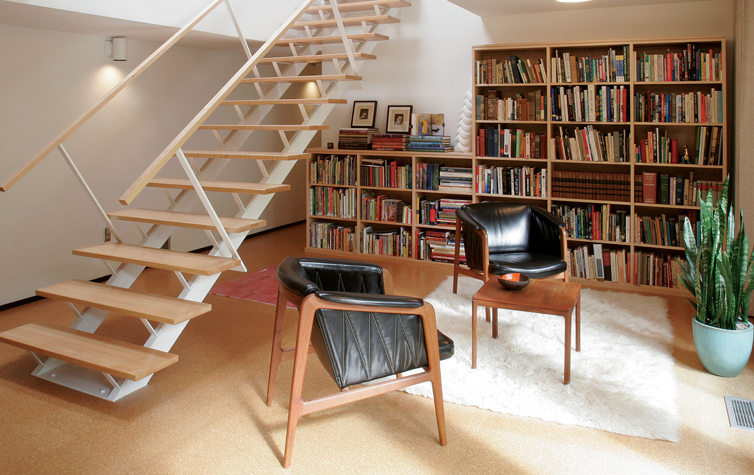
When Erich Volkstorf and Laura Brodax first saw this 1961 home on the market, it was love at first sight (part 2). Of course, it took lots of hard work (and some serious scrubbing) to get the place’s bones in good order (part 1). But when the home was finally spick and span, it was time to get to work imbuing that modernist style into their own personal case study.
Volkstorf’s mantra of consistency and continuity of materials led them to settle on a palette of white maple for floors and cabinets, laminate for kitchen counters and a floating system of cork tiles on the kitchen and downstairs floors. Green slate was used for bathroom counters, the living room fireplace mantel and decorative insets in the flooring. Concrete block faces both fireplaces and off-white is used on all painted surfaces. “It’s easier to do touchup if you only have one paint scheme,” Volkstorf says dryly.
Since they didn’t have blueprints of the as-built structure, Soldano refined the plan and did drawings as the house came apart. He also recommended the deck off the family room be rebuilt smaller and designed a handsome railing for it.
“We really trust Mike; the architects from that period certainly knew how to build things,” Volkstorf comments. “He saw the level of detail we were putting into the house and was always there to make suggestions.”
Volkstorf’s penchant for perfection meant the hollow- core mahogany interior doors and moldings were replaced with solid-core maple doors cleanly installed sans trim—pity the finish carpenters and plasterers who took on that challenge. Closet doors were changed to bypass style and, in addition to replacing the double-pane windows in the master bedroom, all sliding windows got new aluminum versions from Windorco in Seattle.
“The curtain walls in Modernist homes were designed to make the division between inside and outside as transparent as possible,” Volkstorf says in explaining his counterculture decision to remove the double panes. “From a practical standpoint, a double-pane window is more efficient than a single pane, but in relation to a wall, it’s not efficient at all. If a single pane is R-1, a double is only R-2, as opposed to a normal wall, which would be R-16.
“Another issue is the amount of energy consumed in manufacturing the windows. Most of the glass in this house is 40 years old; if you do a life-cycle analysis of a double-pane window, they have a fairly substantial failure rate.”
A self-taught student of modernism, Volkstorf borrowed an idea from Craig Elwood’s Case Study #17: illuminated skylights that function as light sources both day and night. The couple also changed out the original kitchen ball pendants in favor of surface-mounted can lights and illuminated select trees, turning the pitch-black nighttime windows into a view of a naturalistic landscape.
Brodax’s role in the project seems more subtle and supportive than her husband’s, but she drove decisions on the fireplace nook, upstairs storage closets and master bath remodel, where she selected the unglazed porcelain tiles and lobbied for new fixture locations. “I’m more into having the right bedding and towels and having everything neat and looking a certain way,” she says. “I’m more the software and Erich’s the hardware. The big projects scare me, so I’m always the one saying, we can’t do that yet; let’s wait. But then we do it, and it‘s great.”












